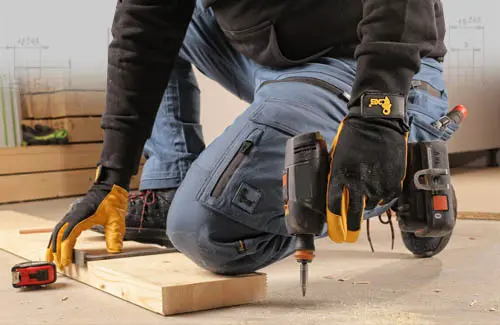The regular price is the current manufacturer's recommended price! FREE shipping for orders over EUR 41,67 within CZ+SK (PPLparcel)

This category includes work trousers, blouses, jackets, sweatshirts, T-shirts, reflective clothing, work vests, rain clothing, disposable clothing, coats, overalls, or special professional clothing (for example, for doctors, emergency services, etc.). Work clothes can also include undershirts, socks, work shoes and other protective elements that increase durability and comfort.
The choice of this specific type of clothing depends mainly on the profession and protection of the worker in various industries. For example, a cook will certainly not need shoes with a protective toe, pants with a bib and a tool belt. An important factor for choosing work clothes is its functionality. It must meet certain protection standards, ideally be equipped with safety and reflective elements to reduce the risk of injury at work as much as possible. Overalls protect us from injury and dirt.
The standard EN 13688 (replacing the standard EN 340:2003) determines requirements that place demands on compatibility, ageing, dimensions and ergonomics, manufacturer's information and labeling of protective clothing. There is a basic requirement for EN340 standard workwear and it is a common type.
The standard EN 342 refers to work clothes designed for cold weather with temperatures that are lower than -5°C.
The standard EN 381 refers to protective clothing for chainsaw workers and determines the clothing requirements for additional specifications. For example, lower limb protection (EN 381-5), jackets (EN 381-11) or protective gloves or leggings. Depending on the speed of the chain, it is further divided into classes (Class 0 to Class 3) according to the speed of 16 to 28 meters per second.
Pictograms are also used to indicate the level of protection that the clothing guarantees.
The shield-shaped pictogram expresses the degree of danger for which the clothing is designed and intended to protect against. This applies, for example, to welding (EN 116 11), protection against chemicals (EN 130 34), static electricity (EN 1149), against adverse weather (EN 343), against heat and flame (EN 531, 470, 533), contamination by radioactivity (EN 1073), etc.
There is a square pictogram where the intended use of the clothing is symbolized.
Symbols for care of clothes (washing, bleaching, ironing, etc.) are also often marked on the label.
The CE marking means a declaration of conformity that the product complies with the basic EU regulation.
How to choose work clothes?
It must be comfortable so that it is not too tight anywhere, it should be well ventilated and made of pleasant material. And as mentioned, follow the profession requirements (which the pictograms help with).
Did you know that:
the first mentions of clothing as such are from 36 thousand years ago, in the times of the Young Paleolithic? And that jeans (jeans, Texas jeans), initially described as the first official work pants, were patented in 1873 by Levi Strauss? Their price was 1 dollar, they were made of cotton and dyed with a dye called: bleu de Gênes (Genova blue).

Other articles:
Bezpečnost našich kotoučů
Jaké druhy klíčů známe?
Zástrčné klíče
Bezodskokové paličky a kladiva